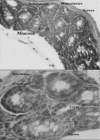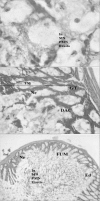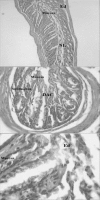Benefits of Zataria multiflora Boiss in Experimental Model of Mouse Inflammatory Bowel Disease
- PMID: 17342240
- PMCID: PMC1810372
- DOI: 10.1093/ecam/nel051
Benefits of Zataria multiflora Boiss in Experimental Model of Mouse Inflammatory Bowel Disease
Abstract
Inflammatory bowel disease (IBD) is a chronic condition of the intestine with unknown etiology involving multiple immune, genetic and environmental factors. We were interested to examine the effect of total extract from Zataria multiflora Boiss, a folk medicinal plant on prevention and treatment of experimental IBD. Z. multiflora was administered (400, 600, 900 p.p.m.) through drinking water to IBD mice induced by intrarectal administration of acetic acid. Prednisolone was used as the standard drug for comparison. Biochemical, macroscopic and microscopic examinations of colon were performed. Biochemical evaluation of inflamed colon was done using assay of myeloperoxidase (MPO) activity and thiobarbituric acid reactive substances (TBARS) concentration as indicators of free radical activity and cell lipid peroxidation. The activity of MPO and lipid peroxidation products (TBARS) increased in acetic acid-treated groups while recovered by pretreatment of animals with Z. multiflora (400-900 p.p.m.) and prednisolone. Z. multiflora (600 and 900 p.p.m.) and prednisolone-treated groups showed significantly lower score values of macroscopic and microscopic characters when compared with the acetic acid-treated group. The beneficial effect of Z. multiflora (900 p.p.m.) was comparable with that of prednisolone. The antioxidant, antimicrobial and anti-inflammatory potentials of Z. multiflora might be the mechanisms by which this herbal extract protects animals against experimentally induced IBD. Proper clinical investigation should be carried out to confirm the activity in human.
Figures








Similar articles
-
Protection by Ziziphora clinopoides of acetic acid-induced toxic bowel inflammation through reduction of cellular lipid peroxidation and myeloperoxidase activity.Hum Exp Toxicol. 2006 Jun;25(6):325-32. doi: 10.1191/0960327105ht626oa. Hum Exp Toxicol. 2006. PMID: 16866190
-
Anti-inflammatory effect of Pycnocycla spinosa extract and its component isoacetovanillone on acetic acid induced colitis in rats.Res Pharm Sci. 2015 Jul-Aug;10(4):345-55. Res Pharm Sci. 2015. PMID: 26600861 Free PMC article.
-
Anti-inflammatory effect of apigenin and hydroalcoholic extract of Dracocephalum kotschyi on acetic acid-induced colitis in rats.Res Pharm Sci. 2017 Aug;12(4):322-329. doi: 10.4103/1735-5362.212050. Res Pharm Sci. 2017. PMID: 28855944 Free PMC article.
-
Pharmacological effects of Zataria multiflora Boiss L. and its constituents focus on their anti-inflammatory, antioxidant, and immunomodulatory effects.Fundam Clin Pharmacol. 2018 Feb;32(1):26-50. doi: 10.1111/fcp.12331. Fundam Clin Pharmacol. 2018. PMID: 29125648 Review.
-
Management of acute cough by Zataria multiflora Boiss as an alternative treatment.J Integr Med. 2018 Jan;16(1):20-25. doi: 10.1016/j.joim.2017.12.006. Epub 2017 Dec 8. J Integr Med. 2018. PMID: 29397088 Review.
Cited by
-
Role of Oxidative Stress and Inflammatory Cytokines (TNF-α and IL-6) in Acetic Acid-Induced Ulcerative Colitis in Rats: Ameliorated by Otostegia fruticosa.Life (Basel). 2021 Mar 3;11(3):195. doi: 10.3390/life11030195. Life (Basel). 2021. PMID: 33802553 Free PMC article.
-
Analgesic effects and the mechanisms of anti-inflammation of hispolon in mice.Evid Based Complement Alternat Med. 2011;2011:478246. doi: 10.1093/ecam/nep027. Epub 2010 Oct 25. Evid Based Complement Alternat Med. 2011. PMID: 19349477 Free PMC article.
-
The Effect of Zataria multiflora on Th1/Th2 and Th17/T Regulatory in a Mouse Model of Allergic Asthma.Front Pharmacol. 2017 Aug 7;8:458. doi: 10.3389/fphar.2017.00458. eCollection 2017. Front Pharmacol. 2017. PMID: 28824424 Free PMC article.
-
Fetal Hemoglobin Inducers from the Natural World: A Novel Approach for Identification of Drugs for the Treatment of {beta}-Thalassemia and Sickle-Cell Anemia.Evid Based Complement Alternat Med. 2009 Jun;6(2):141-51. doi: 10.1093/ecam/nem139. Epub 2007 Dec 11. Evid Based Complement Alternat Med. 2009. PMID: 18955291 Free PMC article.
-
Zataria multiflora extract reverses lipopolysaccharide-induced anxiety and depression behaviors in rats.Avicenna J Phytomed. 2020 Jan-Feb;10(1):78-88. Avicenna J Phytomed. 2020. PMID: 31921610 Free PMC article.
References
-
- Lih-Brody L, Powell SR, Collier KP, Reddy GM, Cerchia R, Kahn E, et al. Increased oxidative stress and decreased antioxidant defenses in mucosa of inflammatory bowel disease. Dig Dis Sci. 1996;41:2078–86. - PubMed
-
- Abdollahi M, Ranjbar A, Shadnia S, Nikfar S, Rezaiee A. Pesticides and oxidative stress: a review. Med Sci Monit. 2004;10:RA144–7. - PubMed
-
- Nielsen OH, Ahnfelt-Ronne I. Involvement of oxygen-derived free radicals in the pathogenesis of chronic inflammatory bowel disease. Klin Wochenschr. 1991;69:995–1000. - PubMed
-
- Barbosa DS, Cecchini REl, Kadri MZ, Rodriguez MA, Burini RC, Dichi I. Decreased oxidative stress in patients with ulcerative colitis supplemented with fish oil omega-3 fatty acids. Nutrition. 2003;19:837–42. - PubMed
LinkOut - more resources
Full Text Sources
Research Materials
Miscellaneous

